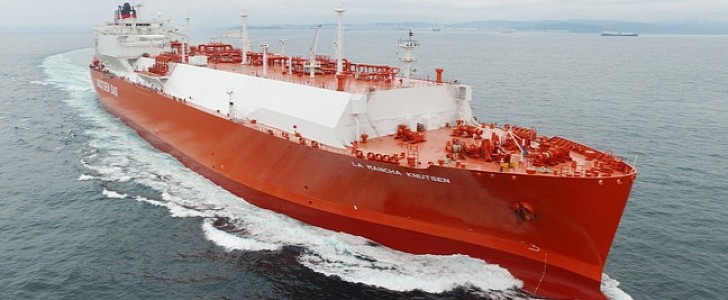Not everyone might agree, but carbon capture is considered one of the best ways of reducing greenhouse gas emissions. In addition to the carbon capture technology itself, this solution also requires dedicated vessels that would transport the liquefied CO2 to the locations where it’s meant to be stored. This led to the birth of a new kind of maritime transportation vehicle, the CO2 carrier, and Hyundai Heavy Industries plans to build the biggest one yet.
Earlier this year, ABS (the American Bureau of Shipping) awarded Approval in Principle for an offshore CO2 injection platform developed by Hyundai Heavy Industries (HHI). The platform is part of a joint venture between ABS and the HHI subsidiary Korean Shipbuilding and Offshore Engineering, which are also designing a renewable hydrogen production platform. Both platforms are set to become operational by 2025.
The carbon-dioxide injection platform is meant to store the CO2 that’s captured on land. After being liquefied at high pressure, the CO2 is transported to the storage location either through pipelines or with the help of a carrier. HHI expects to start storing up to 400,000 tons of carbon dioxide underground, starting in 2025, in Korea’s East Sea gas field.
After receiving approval for the platform design, HHI is now moving to the next step of the project, which is the development of a liquefied CO2 carrier. The 74,000 cm3 (4,515.8 cu-in) design will boast the world’s largest LCO2 capacity. Described as a next-generation, ultra-large carrier, this vessel will be developed by HII together with ABS and the Republic of the Marshall Islands (RMI) Maritime Administrator.
“In order to achieve Korea's national greenhouse gas reduction target (NDC) and global net zero, carbon capture and storage is essential,” said Kim Tae-woo, Senior Vice President and Head of Shipping Division of Hyundai Glovis, part of HHI. Developing this massive LCO2 carrier will not only help expand carbon capture, but will also pave the way for similar ships to do the same in other parts of the world.
The carbon-dioxide injection platform is meant to store the CO2 that’s captured on land. After being liquefied at high pressure, the CO2 is transported to the storage location either through pipelines or with the help of a carrier. HHI expects to start storing up to 400,000 tons of carbon dioxide underground, starting in 2025, in Korea’s East Sea gas field.
After receiving approval for the platform design, HHI is now moving to the next step of the project, which is the development of a liquefied CO2 carrier. The 74,000 cm3 (4,515.8 cu-in) design will boast the world’s largest LCO2 capacity. Described as a next-generation, ultra-large carrier, this vessel will be developed by HII together with ABS and the Republic of the Marshall Islands (RMI) Maritime Administrator.
“In order to achieve Korea's national greenhouse gas reduction target (NDC) and global net zero, carbon capture and storage is essential,” said Kim Tae-woo, Senior Vice President and Head of Shipping Division of Hyundai Glovis, part of HHI. Developing this massive LCO2 carrier will not only help expand carbon capture, but will also pave the way for similar ships to do the same in other parts of the world.







